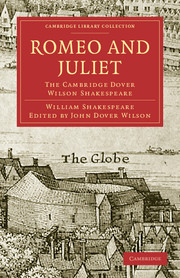THE COPY FOR ROMEO AND JULIET, 1599
Published online by Cambridge University Press: 07 September 2010
Summary
As the F Romeo and Juliet was a mere reprint of Q2 (1599), an editor has only to take Q2 into account together with its predecessor, Q1 (1597); and, as Q2 is now acknowledged by all to be a ‘good’ quarto and Q1 to be a ‘bad’ quarto, his task would at first sight appear an easy one. But in matters textual appearances are often deceptive. And the trouble here is not so much that Q2 is one of the worst of the Shakespearian ‘good’ quartos and Q1 one of the best of the ‘bad’, as that the relations between the two have so far never been satisfactorily defined. This Note is the latest of many attempts. A full account of the issues involved and of the reasons for the solution we ourselves offer would, however, take more space than a volume of this size allows; and what follows is therefore but a summary of our conclusions. These are discussed at length in an article entitled ‘Recent work on the text of Romeo and Juliet’ (Shakespeare Survey, 1955), to which the reader may be referred.
Q1 is ‘bad’ because it is undoubtedly derived from a text reconstructed from memory by an actor or actors who had taken part in performances of the authentic play, though for some reason not yet explained the reconstruction is remarkably good in the first two acts and becomes progressively less successful afterwards.
- Type
- Chapter
- Information
- Romeo and JulietThe Cambridge Dover Wilson Shakespeare, pp. 112 - 118Publisher: Cambridge University PressPrint publication year: 2009First published in: 1955



